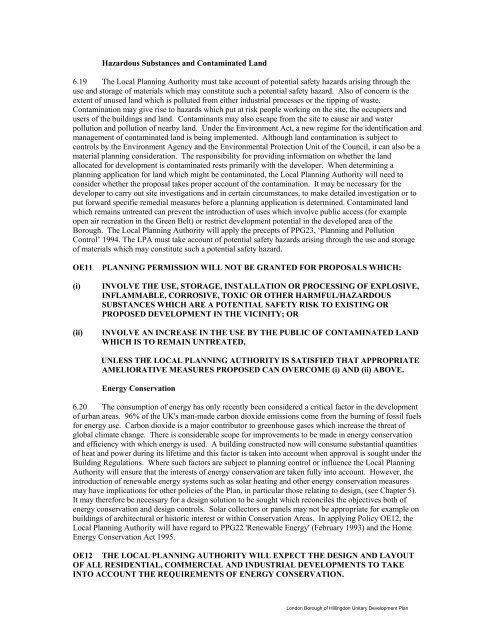HILLINGDON UNITARY DEVELOPMENT PLAN - London Borough ...
HILLINGDON UNITARY DEVELOPMENT PLAN - London Borough ...
HILLINGDON UNITARY DEVELOPMENT PLAN - London Borough ...
You also want an ePaper? Increase the reach of your titles
YUMPU automatically turns print PDFs into web optimized ePapers that Google loves.
Hazardous Substances and Contaminated Land<br />
6.19 The Local Planning Authority must take account of potential safety hazards arising through the<br />
use and storage of materials which may constitute such a potential safety hazard. Also of concern is the<br />
extent of unused land which is polluted from either industrial processes or the tipping of waste.<br />
Contamination may give rise to hazards which put at risk people working on the site, the occupiers and<br />
users of the buildings and land. Contaminants may also escape from the site to cause air and water<br />
pollution and pollution of nearby land. Under the Environment Act, a new regime for the identification and<br />
management of contaminated land is being implemented. Although land contamination is subject to<br />
controls by the Environment Agency and the Environmental Protection Unit of the Council, it can also be a<br />
material planning consideration. The responsibility for providing information on whether the land<br />
allocated for development is contaminated rests primarily with the developer. When determining a<br />
planning application for land which might be contaminated, the Local Planning Authority will need to<br />
consider whether the proposal takes proper account of the contamination. It may be necessary for the<br />
developer to carry out site investigations and in certain circumstances, to make detailed investigation or to<br />
put forward specific remedial measures before a planning application is determined. Contaminated land<br />
which remains untreated can prevent the introduction of uses which involve public access (for example<br />
open air recreation in the Green Belt) or restrict development potential in the developed area of the<br />
<strong>Borough</strong>. The Local Planning Authority will apply the precepts of PPG23, ‘Planning and Pollution<br />
Control’ 1994. The LPA must take account of potential safety hazards arising through the use and storage<br />
of materials which may constitute such a potential safety hazard.<br />
OE11<br />
(i)<br />
(ii)<br />
<strong>PLAN</strong>NING PERMISSION WILL NOT BE GRANTED FOR PROPOSALS WHICH:<br />
INVOLVE THE USE, STORAGE, INSTALLATION OR PROCESSING OF EXPLOSIVE,<br />
INFLAMMABLE, CORROSIVE, TOXIC OR OTHER HARMFUL/HAZARDOUS<br />
SUBSTANCES WHICH ARE A POTENTIAL SAFETY RISK TO EXISTING OR<br />
PROPOSED <strong>DEVELOPMENT</strong> IN THE VICINITY; OR<br />
INVOLVE AN INCREASE IN THE USE BY THE PUBLIC OF CONTAMINATED LAND<br />
WHICH IS TO REMAIN UNTREATED,<br />
UNLESS THE LOCAL <strong>PLAN</strong>NING AUTHORITY IS SATISFIED THAT APPROPRIATE<br />
AMELIORATIVE MEASURES PROPOSED CAN OVERCOME (i) AND (ii) ABOVE.<br />
Energy Conservation<br />
6.20 The consumption of energy has only recently been considered a critical factor in the development<br />
of urban areas. 96% of the UK's man-made carbon dioxide emissions come from the burning of fossil fuels<br />
for energy use. Carbon dioxide is a major contributor to greenhouse gases which increase the threat of<br />
global climate change. There is considerable scope for improvements to be made in energy conservation<br />
and efficiency with which energy is used. A building constructed now will consume substantial quantities<br />
of heat and power during its lifetime and this factor is taken into account when approval is sought under the<br />
Building Regulations. Where such factors are subject to planning control or influence the Local Planning<br />
Authority will ensure that the interests of energy conservation are taken fully into account. However, the<br />
introduction of renewable energy systems such as solar heating and other energy conservation measures<br />
may have implications for other policies of the Plan, in particular those relating to design, (see Chapter 5).<br />
It may therefore be necessary for a design solution to be sought which reconciles the objectives both of<br />
energy conservation and design controls. Solar collectors or panels may not be appropriate for example on<br />
buildings of architectural or historic interest or within Conservation Areas. In applying Policy OE12, the<br />
Local Planning Authority will have regard to PPG22 'Renewable Energy' (February 1993) and the Home<br />
Energy Conservation Act 1995.<br />
OE12 THE LOCAL <strong>PLAN</strong>NING AUTHORITY WILL EXPECT THE DESIGN AND LAYOUT<br />
OF ALL RESIDENTIAL, COMMERCIAL AND INDUSTRIAL <strong>DEVELOPMENT</strong>S TO TAKE<br />
INTO ACCOUNT THE REQUIREMENTS OF ENERGY CONSERVATION.<br />
<strong>London</strong> <strong>Borough</strong> of Hillingdon Unitary Development Plan
















